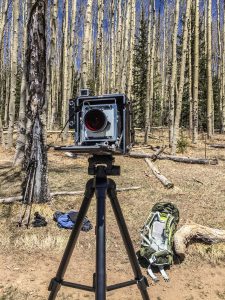I use a 4″ x 5″ sheet film camera for a single reason. With care, single negatives can produce higher resolution images than individual frames from a digital camera. There is also controversy about the dynamic range that can be captured with both technologies. These pages document my experiments to determine if large format film still beats digital … or not.
My current equipment
Crown Graphic 4×5 manufactured in 1947. I currently (Spring 2018) have two lenses, the 127mm f/4.7 Ektar that came with the original camera and a 1986 Schneider/Kreuznach Super Angulon 90mm f/8. 
I have used 3 films
- Kodak Tri-X 400
- Kodak Tmax 100
- Arista EDU 100
Workflow
The negatives are processed in a Stearman SP-445 tank, 4-at-a-time. I digitize them with my Canon EOS M5 (sometimes my M3) with a 28mm macro lens on a light table. Generally I tile 9 overlapping macro images in a 3×3 grid that covers the entire 4″x5″ negative. The images are assembled with the panorama feature in Adobe Photoshop. This results in raw images that are about 80-100 megapixels and resolve the photographic grain. The negatives are inverted in Photoshop. Because they are digitized as Canon Raw, they are in color, but are converted to black and white in Photoshop and then inserted into the usual workflow used for digital images.
Development
Currently I have only used the Agfa developer Rodinal. I have no good reason for having chosen Rodinal other than it’s what I had used in the Sixties when I first developed back and white film. Agfa sold the rights for Rodinal to Adox about five years ago. It is now available as Adenol in the States, but still under the Rodinal name in Europe.
These are my standard development times. For the Stearman Tanks to make 470 ml:
- Pre-soak: 5 minutes
- Developer Rodinal (1:50 dilution): 9.2 ml + 460.8 ml water, 20C, agitation 1 min continuous, then 5 sec every 30 sec.
- Tmax100: 12 min
- Arista EDU 100: 7 min
- Arista EDU 100 @N-1: 5 min
- Stop: 7.5ml + 462.5 ml water, 30 sec at 20C
- Fixer: 117.5 ml + 352.5 ml water, 5-10 minutes at 20C
- Wash: 10 minutes
- Photo Flo: 2.5 ml + 467.5 ml distilled water, 30 sec
Resolution Study
My digital camera, a Canon EOS M5 produces 24 megapixel images (6000×4000 pixels). There are more expensive digital cameras that produce higher resolution, but the M5 is my benchmark for these comparisons.
Dynamic Range Study
